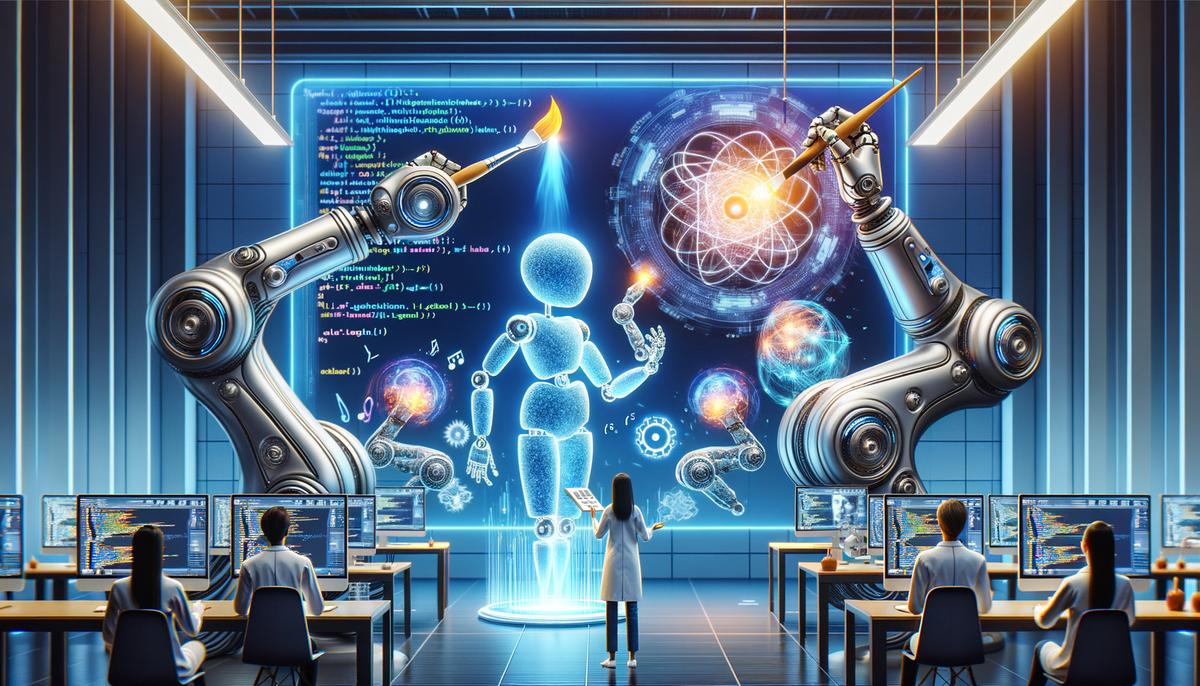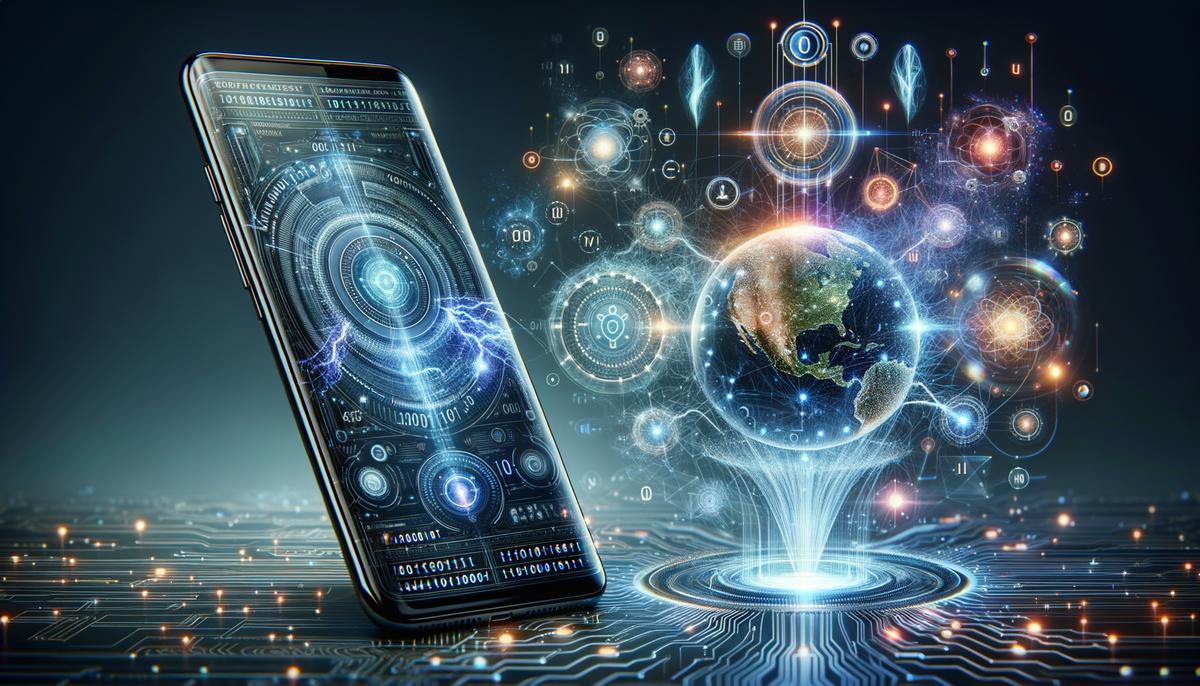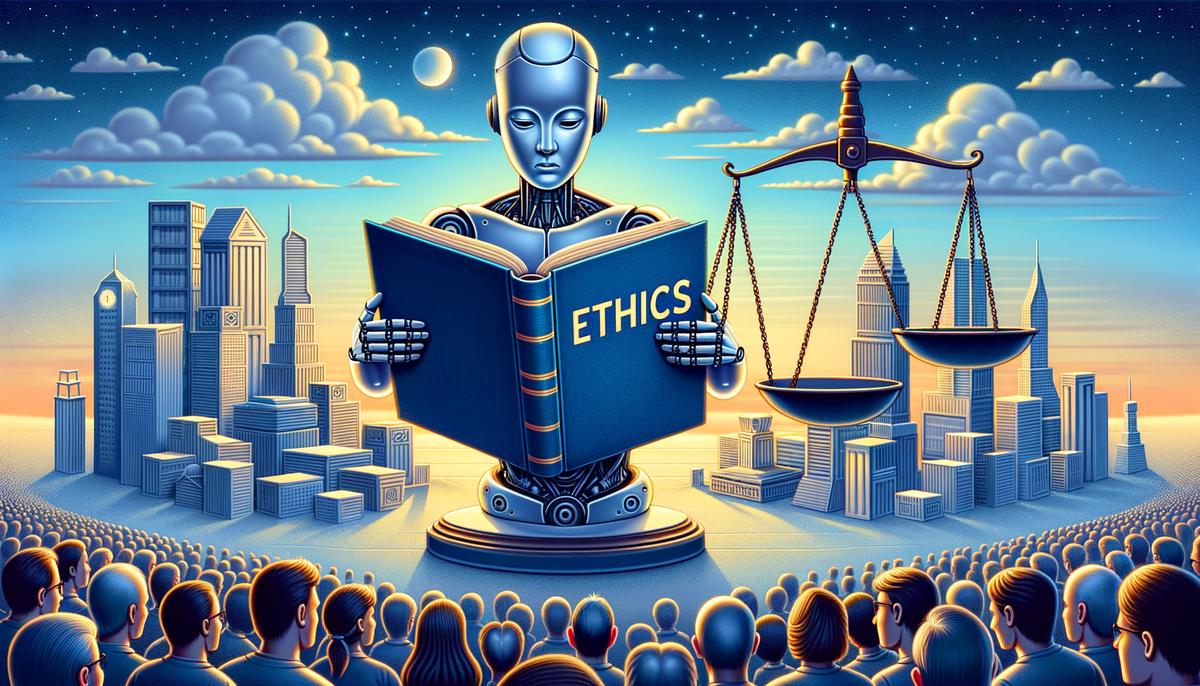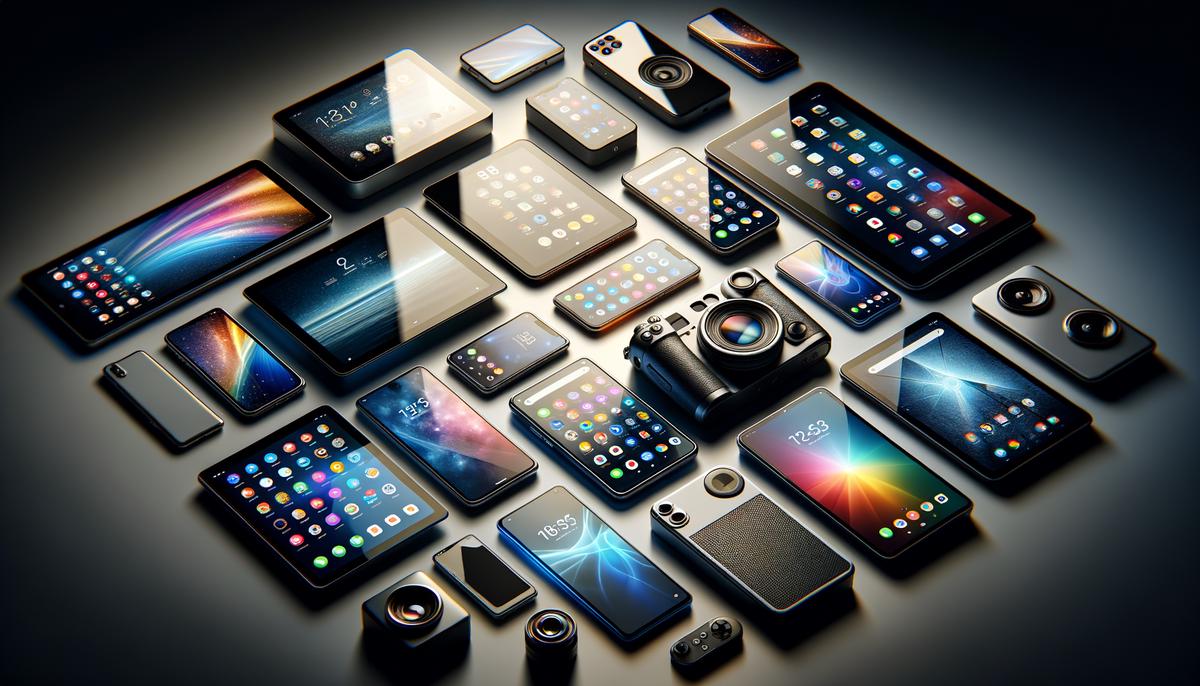Generative AI is like having a creative genius inside our gadgets, capable of crafting everything from snazzy graphics to cool tunes, almost like magic. At its core, generative AI uses smart algorithms to dream up data that feels fresh and new. Picture a computer creating dazzling images or composing catchy melodies without a human touching a paintbrush or a piano key. What’s even more exciting is seeing this cutting-edge tech move right onto our devices. By shifting from the cloud to our pockets, generative AI is not just about privacy, but it’s about getting results fast, wherever we are, internet or not. This leap is revolutionizing how our devices learn from us, making everything from our phones to our fridges not just smart, but truly personalized geniuses.
Contents
Understanding Generative AI
Generative AI is a cutting-edge technology that’s creating a buzz in the world of computing, and for good reason—it’s the art of teaching machines to make new things. Just like an artist with a blank canvas, generative AI can whip up anything from a catchy tune to a realistic image or even write its own stories. It’s a bit like having a robot that’s not just smart, but also has a spark of creativity.
To picture how generative AI works, imagine a chef learning to cook by studying a pile of recipes. The chef learns what ingredients typically go together, and how they’re mixed and cooked to create a dish. Now, think of a computer program doing something similar, but with data. Generative AI takes loads of information — whether it’s pictures, words, or numbers — and learns patterns and rules from this data.
After this learning phase, which is called “training,” the AI is ready to start creating. It uses the rules it’s learned to generate new content that follows the patterns of the data it studied. This could be a new melody that sounds like it came from a pro musician, or a convincing article written on a trending topic.
But generative AI isn’t just a one-trick pony. There’s a specific kind known as a “Generative Adversarial Network,” or GAN, and it’s pretty clever. Picture two AIs having a bit of a friendly competition. One AI makes something new, like a picture, and the other AI tries to guess if it’s made by a human or its AI buddy. Over time, the creator AI gets so good that the judge AI can’t tell the difference anymore. This means the content it creates is super realistic!
And finally, this technology is not in some far-off future; it’s here now. Generative AI is the brain behind those nifty filters that turn your selfie into a classical painting, or applications that can write cool code snippets—all because it learned from heaps of examples. But remember, it’s only as good as the data it learns from. Feed it quality stuff, and it’ll produce quality work.
So there you have it: generative AI is like having a creative assistant that never sleeps, always learning, and always making something new. It’s pushing the boundaries of what we think machines can do, blending lines between human and computer-generated content, and stepping into a future where our digital co-workers are not just smart, but also truly inventive.

The Shift to On-Device AI
Shifting Generative AI to standalone devices is a formidable shift in the digital landscape, akin to supercharging a vehicle while streamlining its handling. This transition brings computing prowess typically confined to sprawling data centers right into our palms and onto desktops. To grasp the magnitude of this leap, picture a sculptor working tirelessly with hammer and chisel, suddenly handed the power to mold masterpieces with thoughts alone.
As AI steadily infiltrates daily life—nesting within smartphones, tablets, and across the Internet of Things (IoT)—embedding generative AI directly into devices heralds a new era of efficiency and accessibility. Devices no longer act as mere gateways to remote servers; they become autonomous creators, capable of producing original content at command — without the crutch of an internet connection.
For instance, consider a smartphone that can generate real-time language translations without pinging a distant server, or a smartwatch that concocts a motivational workout playlist tailored to your pulse and preferences, all curated on-the-fly. Device-based generative AI makes this possible, transforming gadgets into self-sufficient companions that learn and adapt to user needs instantaneously.
The significance of localized generative AI isn’t merely about convenience or speed; it’s a crucial stride in privacy and security. Data that stays on-device doesn’t traverse the perilous paths of the web, where prying eyes and nefarious actors notoriously prowl. Therefore, proprietary or sensitive information—be it medical records woven into personalized health insights or business strategies remolded into competitive reports—remains under the user’s control.
For areas with spotty internet service or during travel, on-device generative AI ensures a constant companion, unfettered by the limitations of network reach. Photo editing apps, for instance, can harness the device’s integrated AI to enhance images or generate artistic renditions instantly, regardless of cellular or Wi-Fi connectivity.
Moreover, offloading tasks to devices mitigates bandwidth strain on networks, a blessing as more gadgets vie for online space. It also slashes latency, that annoying lag between a request and response, ensuring promptness vital in applications like virtual reality, where milliseconds count for a seamless experience.
Developers, too, revel in this paradigm shift, as on-device generative AI paves the way for novel applications previously fettered by the constraints of cloud dependency. This autonomy allows for crafting more responsive and personalized user experiences that can learn and evolve in real time.
Considering battery life, the transition to self-reliant devices with embedded generative AI is nothing short of revolutionary. Relinquishing the need to continuously communicate with remote servers eases the energy demands placed on devices, optimally balancing performance and battery longevity.
In summary, migrating generative AI directly onto devices reshapes the interaction between humans and machines, sparking advancements that touch upon every facet of modern technology. This integration leads to smarter, more intuitive devices capable of tasks that once belonged solely in the realm of science fiction. It stands as a testament to human ingenuity and the relentless pursuit of a more personal and responsive technological future.
As the tech community and consumers alike watch this evolution unfold, the excitement is palpable. The implications of on-device generative AI are vast and diverse, promising to redefine our digital experiences in ways we are only beginning to imagine.

Impact on Personalization and UX
Enhanced Personalization Through On-Device Generative AI
Imagine your digital gadgets getting to know you so well they can predict what you’ll type next or the kind of evening playlist you’d love. On-device generative AI is turning that into reality. But it’s not just about predicting; it’s about creating personalized experiences that feel tailor-made just for you.
Until recently, AI learning and creation typically happened in the cloud. Now, the trend is to bring this power right onto your devices – think smartphones, smartwatches, and even your car’s infotainment system. This shift isn’t just a techy headline; it’s a game-changer for how we interact with our digital worlds.
Having generative AI on your device means it can create content with zero wait time. It’s like having your own digital chef that concocts dishes instantly, using ingredients right from your fridge. Whether it’s whipping up unique responses to emails or generating custom graphics for a presentation, on-device AI does this while keeping your personal data safely within your device’s four walls.
This not only boosts convenience but also ramps up device efficiency. Your data doesn’t need to travel far and wide over the internet; it’s processed on the spot. Faster results, and for those who are privacy-conscious, it’s a breath of fresh air knowing that their data isn’t floating around the cloud.
Let’s consider those in remote or rural areas where internet service can be as shaky as a three-legged table. On-device generative AI brings advanced capabilities to their fingertips, no matter the quality of their network connection.
For the tech-savvy and creators, having generative AI baked into devices opens up a new frontier. They can build apps and services that run smartly and swiftly, unhindered by the need for constant internet connectivity.
Battery life gets a boost, too. With the intelligence local, devices can manage their power much more efficiently – they aren’t wasting juice on data-heavy tasks like sending your info back and forth to a server halfway across the globe.
But what truly spells a revolution is how this tech is changing our relationship with machines. Interactions are becoming increasingly natural as AI learns from our behavior, adapts, and even anticipates our needs and preferences. It’s a peak into a future where digital experiences are not just smart but feel intuitively personalized. The potential of on-device generative AI to redefine our digital experiences stirs a blend of promise and excitement. It’s not just about the tech itself but how it enhances our daily lives, making our interactions with technology more personal, immediate, and real.
From artists to day-to-day users, the implications are massive. As devices grow smarter and more self-sufficient, on-device generative AI positions itself at the heart of an ongoing personalization revolution. The question isn’t if it will reshape our lives but rather how soon we’ll wonder how we ever did without it.

Generative AI in Everyday Applications
Generative AI is poised to change the landscape of everyday applications significantly. In various sectors, we can expect transformations that will enhance the user experience, boost creativity, and streamline operations. Here are some everyday applications that will be transformed by generative AI:
- Healthcare: In the world of medicine, generative AI can revolutionize diagnostics. By analyzing medical imagery, such as X-rays and MRI scans, AI can assist in detecting abnormalities with precision that rivals human experts. Beyond diagnostics, generative AI has the potential to create personalized treatment plans by synthesizing a patient’s medical history with a vast array of medical data.
- Education: For education, generative AI holds the promise of personalizing learning materials. AI can generate practice problems, interactive quizzes, and even textbooks tailored to a student’s learning style and progress. This individualized approach could reshape the traditional classroom, making learning more efficient and engaging.
- Entertainment: The entertainment industry stands to benefit greatly as generative AI enhances content creation. AI can assist in scriptwriting, generating compelling narratives based on genre trends. In gaming, generative AI could create dynamic and responsive game worlds that change based on player actions, leading to a truly personalized gaming experience.
- Retail and Fashion: In the retail sector, generative AI could transform the online shopping experience by generating lifelike virtual models, allowing customers to see how clothes look on personalized avatars. This technology helps in predicting fashion trends by analyzing social media and current events, enabling designers to create in-demand styles efficiently.
- Art and Graphic Design: The role of generative AI in art cannot be understated. It can provide artists with new tools for creativity, generating patterns, textures, and even complete works of art. In graphic design, AI could automate tedious tasks, such as creating multiple design iterations, freeing designers to focus on the more creative aspects of their work.
- Product Design and Manufacturing: Product designers can harness generative AI to propose multiple iterations of a product, each optimized according to different criteria such as cost, materials, and functionality. In manufacturing, AI algorithms could predict machine maintenance needs or assist in quality control by identifying defects in real-time.
- Finance: Financial institutions can use generative AI to enhance customer service with chatbots that handle inquiries with the sophistication of a human assistant. Fraud detection can also be improved, with AI generating patterns of normal user activity and signaling anomalies for further investigation.
- Agriculture: In agriculture, generative AI has the potential to optimize crop yield by analyzing satellite images and weather data, generating planting and harvesting schedules, and even guiding autonomous farm equipment to carry out tasks more efficiently.
- Cooking and Recipe Development: For the culinary curious, generative AI can create recipes based on ingredients at hand, dietary restrictions, and flavor profiles. This not only inspires home chefs but could also aid professional chefs in developing new dishes.
- Architecture and Urban Planning: Architects and urban planners can use generative AI to visualize new structures and city layouts, generating countless iterations based on specific zoning laws, environmental considerations, and community needs.
These applications are just scratching the surface of generative AI’s potential. As this technology becomes more sophisticated, we can anticipate even more robust and innovative uses across various sectors, enhancing our lives and work in ways we’re just beginning to imagine.

Challenges and Ethical Considerations
Moving on from the foundational understanding of on-device generative AI and its numerous applications, we delve into the challenges and ethical considerations surface. A key obstacle to on-device AI is the computational demand it places on devices; power and thermal constraints restrict the scope of tasks. Generative AI, in particular, may demand significant processing resources for tasks like image generation or language modeling, potentially leading to faster battery consumption and device wear.
Another major concern is data bias. The content generated by AI is only as unbiased as the data it’s been fed. Inaccurate or prejudiced datasets can lead to AI outputs that perpetuate stereotypes and misinformation. This is especially troubling when generative AI is used in sensitive areas like news dissemination or educational content creation.
Privacy, while enhanced by on-device processing, also presents challenges. Even if data does not leave the device, generative AI might produce content that includes personal information, thus raising concerns about whether generated outputs could inadvertently reveal more about a user than intended.
The potential for misuse must be acknowledged. With the capability to generate deepfakes or create fake news articles, the technology could be weaponized to spread disinformation or infringe on privacy rights. Users and creators alike need to understand that with the power of on-device generative AI, comes the responsibility to use it ethically.
There are also questions about intellectual property rights. When an AI generates a piece of artwork, music, or writing, who owns it? The lines of copyright can blur when outputs are derivative works based on a vast database of human-created content. Determining ownership and due credit is a complex issue that society will need to address as this technology becomes more widespread.
Looking at the workforce, the advancement of AI could potentially overshadow human skills. For example, if generative AI becomes capable of producing complex designs, it could diminish the demand for human designers. As such, there might be a need for new skill sets, and the current workforce may have to adapt to work alongside AI.
Another part of the ethical discussion centers on the concept of authenticity. With machines creating content that is increasingly indistinguishable from human creations, the value placed on human artistry may shift. Public perception and acceptance of AI-generated content are constantly evolving, and what is deemed as authentic or valuable might change over time.
Furthermore, ensuring accessibility is a substantial ethical concern. As generative AI becomes integrated into products, it’s crucial that developers make these tools available to diverse populations to avoid creating a digital divide where only certain groups benefit from advancements in AI.
Lastly, the ethical programming of AI systems warrants attention. As AI begins to interpret and mimic human emotions and reactions, instilling ethical guidelines into AI design is vital. Societal norms and values should guide the creation and implementation of these technologies to promote positive outcomes and prevent harmful biases.
These challenges and ethical considerations are but a few that stakeholders must address. As generative AI on devices becomes increasingly common, the public, policy-makers, and tech companies must work together to navigate these complex waters, ensuring that the future shaped by this technology is one that benefits all and reflects the best of human values.

The Future Landscape of On-Device AI
As technology leaps forward, we’re on the cusp of witnessing the nexus between generative AI and the devices we use every day. With the rapid evolution of AI, it’s only natural that the power of generative AI is being packaged into the devices themselves, untethering from the need for cloud connectivity. This shift to on-device generative AI isn’t just a technical update; it’s a move that could redefine our digital world.
Imagine your smartphone, now a studio for instant content creation. It’s not just convenient; this is a step towards a new level of device efficiency. Processing data locally means tasks that once tapped into the cloud’s vast resources are now done in the palm of your hand. This not only could ramp up the speed at which we operate but also safeguards privacy. When data doesn’t leave the device, the opportunity for leaks plummets.
For those in remote locations or areas where internet service feels like a time capsule to the dial-up era, on-device generative AI is nothing short of a technological liberator. It opens a gateway for advanced capabilities to thrive in every corner of the globe.
The implications don’t stop at personal convenience or global accessibility. Consider the sparks of innovation it lights for the tech-savvy and creative minds. On-device generative AI invites a new era of app development, unshackling creators from the limitations and dependencies of continuous internet connections.
Think of the battery life advantages. With on-device AI handling the brunt of computational tasks, there’s less reliance on servers miles away, and fewer signals bouncing to and fro saves precious energy, potentially revolutionizing battery life.
This integration of on-device generative AI isn’t just a feature addition; it’s reshaping our relationship with our machines. The devices we use are transitioning from tools to partners, interacting with us naturally, learning our preferences, and delivering personalized experiences unlike ever before.
The excitement surrounding this wave of technology is palpable. On-device generative AI could not only transform our digital experiences but also redefine the relationship between creation and consumption. It holds a future where devices aren’t just smart; they’re insightful, a blend of artistry and intelligence that elevates our digital interactions to new heights.
In every sector, from medicine to design, the ramifications of on-device generative AI promise advancements. For instance, doctors could have immediate access to medical imaging analysis without waiting for remote processing. Designers could tweak 3D models in real-time, their devices anticipating and rendering changes on the fly.
As we peer behind the curtain of this emerging tech trend, we uncover a landscape ripe for transformation. This isn’t just about keeping data local or cutting down on latency; it’s about harnessing the combined creativity and intelligence of humanity and machines to ignite a revolution in the way we live and work. On-device generative AI is becoming the silent engine driving the future of our digital experiences, and as it gathers pace, we stand at the threshold of a new era in our digital evolution.

As we stand on the brink of a new era with on-device generative AI, we’re not just looking at gadgets that understand us better but at a future that reshapes our world. This technology’s journey is filled with towering achievements and tricky hurdles, from the scintillating potential of hyper-personal devices to the thorny issues of keeping our data safe and dealing with fake content. Yet, as we navigate this path, we are shaping a horizon where our interaction with technology becomes more fluid, intuitive, and, ultimately, more human. It’s a landscape brimming with possibilities, ready to be defined by our choices, innovations, and the ways we decide to embrace this AI renaissance.
